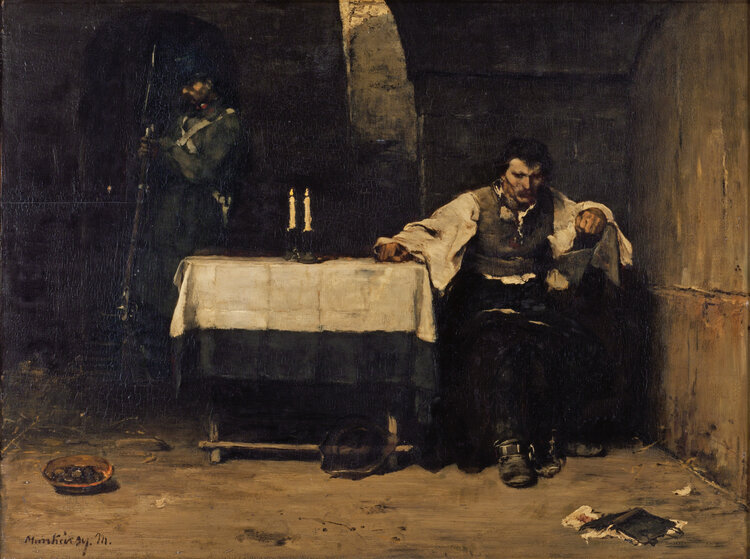Collection Connection is a series of personal responses by Museum staff to works in the Frye Art Museum’s collection.

Mihály de Munkácsy. The Condemned, 1869–72. Oil on panel. 31 x 39 1/2 x 3/8 in. Frye Art Museum, Founding Collection, Gift of Charles and Emma Frye, 1952.125. Photo: Spike Mafford
One of the reasons I entered the museum field is I believed art can create change. Sometimes that reason still comes to mind when I consider the motivations behind my continued career in the arts. But, since I heard artist and activist Martha Rosler speak in Seattle several years ago, a sentiment she relayed has stayed with me: “I’ve never believed that art changes the world.” She went on to explain how activism must instead come from people. I’ve found myself frequently considering the relationships between art, people, and activism ever since.
A work of art in the Frye’s Founding Collection that has brought those relationships to mind is The Condemned (1869–72) by Hungarian Realist painter Mihály de Munkácsy (1844–1900). Inspired by travels in his twenties to Paris and the paintings he saw by Gustave Courbet, Jean François Millet, and the Barbizon School, Munkácsy focused the style and subject matter of his early works on authentic, objective perspectives of the society and reality of his time—Hungary in the aftermath of the Revolution of 1848–49 and the country’s fight for independence from Austria.
As The Condemned focuses our attention on the psyche and individual humanity of a shackled prisoner, the painting prompts us to consider the subject’s personal context—was this man an artist himself? A poet? A political activist? Coupled with the artist’s related, highly acclaimed painting The Last Day of a Condemned Man (1870), which expands the same scene to include others making a final visit to the condemned man—the people whose lives have been affected by his incarceration—these works give us the opportunity to interrogate our own views on the larger moral questions surrounding criminal justice systems and the ways we respond to the humanity of the people in our prisons.
Hank Willis Thomas and Baz Dreisinger. The Writing On the Wall , 05.10.20
Similar issues were recently raised in the context of the current global pandemic as the words “We are the voices behind the wall” were projected in massive yellow letters across the US Department of Justice in Washington, D.C. several weeks ago. The interventions were part of The Writing on the Wall, a traveling public art installation by Hank Willis Thomas and Baz Dreisinger in which poems, letters, stories, and other writings by incarcerated individuals are illuminated on buildings affiliated with the US prison system. The project takes on a particular urgency in the present moment of American history. As COVID-19 continues ravaging US prisons, including our own in Washington State, publicly available data and demographics on those who have become infected inside them remain largely absent. Moreover, since George Floyd’s murder on May 26, more than 10,000 people have been arrested in relation to the nation-wide Black Lives Matter movement and protests against institutionalized police brutality and systemic racism against Black Americans. When the present version of The Writing on the Wall debuted in Manhattan this past May, Thomas told Artnet, “Now more than ever… we wanted people to heed these voices. We wanted to literally center them at the heart of New York City in the middle of a pandemic as an insistence that they not be forgotten and must be attended to.”
Another artist bringing the voices of incarcerated people to the fore during the pandemic is Shaun Leonardo. The New York artist’s performances and social practice works take on issues such as mass incarceration, police violence, and gun control; the latter was addressed through Primitive Games, which he performed at the Guggenheim Museum in 2018. Leonardo planned to center a new iteration of Primitive Games on people affected by the prison system. But when the performance was postponed due to the pandemic, Leonardo shifted his project to focus on lobbying for inmate release programs. The artist spoke with The Art Newspaper about the way life in prison is defined by the trauma of isolation that we have all recently become more familiar with, which creates a unique opportunity for empathy in this moment. He has been working to connect participants in his project with the New York Mayor’s Office of Criminal Justice to suggest more human responses within prisons during the pandemic.
Shaun Leonardo: Primitive Games, 2018. Guggenheim Museum.
Returning to Rosler and the idea that art cannot create change, in light of these artworks, I see it more in the sense that art alone cannot create change. I also consider a quote from Shaun Leonardo: “When we no longer look, we shut out the possibility of change.” In the end, art can shine a light on aspects of society we aren’t always willing or able to see, but it remains on us to internalize what we’ve witnessed and become more than simply viewers.
Related reading and action resources I referenced when writing this post include:
The Center for Prisoner Health and Human Rights
The Sentencing Project
The Marshall Project: Nonprofit Journalism About Criminal Justice
The Bail Project
Erin Langner
Exhibitions and Publications Coordinator